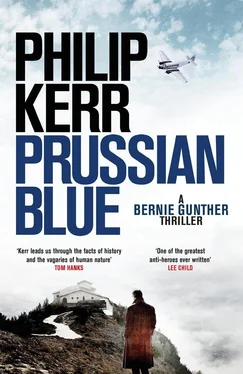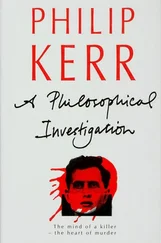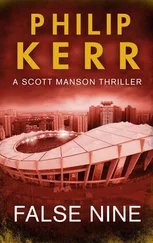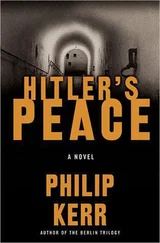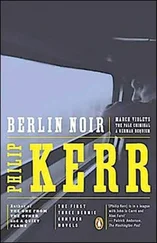A few days later I arrived in Munich. Of course, I’d have preferred it to have been Berlin I was returning to, but home was out, possibly forever; surrounded by the GDR, it was pointless even thinking about it. Berlin looked like a pearl of freedom in a bucketful of ball bearings and, probably, was the second-most beleaguered place on earth. I might as well have tried to get into Budapest, which the Red Army’s tanks were currently blowing to pieces following the Hungarian uprising. Besides, I knew lots of people in Berlin and what was worse they knew me, so I thought Munich was best. It wasn’t like it used to be, but it would do. Besides, Munich was in the American zone, which meant there was always money to be made there. And while Bernie Gunther and Walter Wolf may have been wanted by the Amis and the French, Christof Ganz was a man without a past, which suited me very well because without a past I at least had a fighting chance of having a future.
On my first night back in Munich my aimless footsteps led me from the Christliches Hospiz in Mathildenstrasse, where I was staying, to Odeonsplatz and the Feldherrenhalle, which was a copy of the Loggia dei Lanzi in Florence. While I haven’t seen the original building myself I can easily imagine that it probably contains some beautiful Renaissance marble statues and works of art in bronze — all very Italian. The Munich copy contained a monument to the Franco-Prussian war and a couple of heavily oxidized statues to some now forgotten Bavarian generals. All very German and, once, very Nazi, too: on the left of the Feldherrenhalle, in Residenzstrasse, there had been a memorial to the so-called beer-hall putsch, but that was now gone and so, thank God, was the misguided man who’d instigated this doomed attempt at a coup d’état. But the jackboot echoes were still there and probably so were a few of the ghosts. And as I stood there brooding on the old Germany, I managed to forget the foreign tourists who were still milling about. Gradually they melted away and, perhaps more important, so did I. Then a dark cloud shifted, revealing the bright moon, and I was suddenly able to picture the scene that had existed there on that fateful day back in November 1923, as if I’d been in a cinema theater. Theodor Mommsen probably puts it better than Christof Ganz, but for a brief, enchanted, almost transcendental point in time, I perceived how history was nothing more than an accident, a fluke, a matter of a few centimeters here or there, a head turned, a sudden gust of wind, a dirty gun barrel, a misfired cartridge, a breath held for a second too long or too little, an order misheard or misunderstood, an itchy trigger finger, a second’s delay, an instant’s hesitation. The idea that anything is ever meant to be seemed nonsensical; small causes can have large effects, and some words of Fichte came to mind, about how you could not remove so much as a grain of sand from its place without changing something in the immeasurable whole.
When Adolf Hitler, Ludendorff, and more than two thousand SA men had marched to this spot from the Bürgerbräukeller some two kilometers away, they encountered a blockade made up of a hundred and thirty policemen armed with rifles. The standoff that took place ended when one of those guns — history doesn’t tell us to which side it belonged — was fired, after which there was a lot of shooting on both sides. Four policemen and sixteen Nazis were killed. By all accounts Göring was struck by a bullet in the groin, while some of the men standing beside Adolf Hitler were killed outright, so perhaps it was hardly surprising he thought he had been picked by God to lead the country. Had he, I wondered, ever really believed that what he was doing was right? Or was it that he had been possessed by a misplaced and overriding devotion to pan-Germanism, which is to say he was infected with too much Germany as an idea, in inverse proportion to no Germany at all, which was the situation that existed until the unification that followed the conclusion of the Franco-Prussian war of 1871? It was of course unfortunate that the outcome at the Feldherrenhalle had not produced an alternative result. History would certainly have been very different. But I could hardly argue with the blockade or the decision to shoot, only the marksmanship.
It seemed that for once the Bavarian police had been doing their job properly.
Author’s note and acknowledgments
Following Heydrich’sassassination in June 1942, Ernst Kaltenbrunnerbecame the chief of the RSHA, which comprised Kripo, the Gestapo, and the SD, in January 1943; he was tried as a war criminal at Nuremberg and hanged in October 1946.
Hans-Hendrik Neumannremained Heydrich’s adjutant until the capitulation of Poland in 1939, when he was sent to Warsaw to set up the SD office there. Subsequently he became police attaché at the German Embassy in Stockholm in 1941, again on Heydrich’s orders; and then served with the SS in Norway. After serving a short prison sentence he joined Philips Electrical GmbH in Hamburg where he worked for the rest of his life. He retired in 1975, and died in June 1994.
Gustav Landauerwas a leading anarchist at the beginning of the twentieth century. He was stamped to death by members of the Freikorps in May 1919. His last words were, “To think that people like you are human.”
Colonel Johann Hans Rattenhuber’s RSD units murdered hundreds of Jews at Hitler’s Werewolf HQ in January 1942. He was captured by the Russians in May 1945 and served ten years in prison before being released by the Soviets in October 1955. He died in June 1957.
Major Peter Höglfollowed Hitler into the Führerbunker in early 1945. It seems probable that he commanded the firing squad that executed Himmler’s liaison man and Eva Braun’s brother-in-law, Hermann Fegelein, on April 28, 1945. Högl was killed on May 2, 1945, while crossing the Weidendammer Bridge under heavy fire in Berlin.
The fate of Arthurand Freda Kannenberg, who were the house managers at the Berghof, is unknown.
Martin Bormannbecame Hitler’s private secretary and the most powerful man in Germany after Hitler himself. He died while making his escape from the Führerbunker on May 2, 1945. His co-conspirator in the murder of Walther Kadow in 1923, one Rudolf Höss, was released from prison in 1928; he joined the SS in 1934, and subsequently became the commandant of Auschwitz concentration camp. He was hanged as a war criminal in Warsaw in 1947.
Albert Bormannflew out of Berlin in April 1945. He was arrested in 1949 and, having served six months’ hard labor, was released that same year. He refused to write his memoirs and never ever spoke about his elder brother, Martin. He died in April 1989.
Wilhelm Zanderaccompanied Hitler to the Führerbunker in early 1945. Zander was one of three men Hitler entrusted to take his political testament and effective command of German forces to Admiral Doenitz in April 1945. He survived the war and died in Munich in 1974.
Wilhelm Brücknerwas sacked by Hitler in October 1940 and replaced as chief adjutant by Julius Schaub. He joined the German army and by the end of the war held the rank of colonel. He died in Chiemgau in August 1954.
Dr. Karl Brandttook charge of the Aktion T4 Euthanasia Program in 1939, which gassed some seventy thousand victims. He was one of the defendants in the so-called Doctors’ Trial, which began in 1946. Charged with carrying out medical experiments on prisoners of war, he was found guilty and hanged in June 1948.
The Krauss brotherswere Berlin’s most famous burglars. They really did burgle the police museum. Their fate is unknown to the author.
Читать дальше
